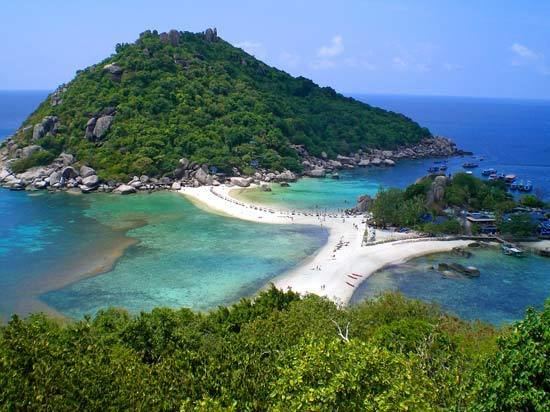Primary inflows Max. depth 85 m (279 ft) | Type Gulf Average depth 58 m (190 ft) Area 320,000 km² | |
 | ||
Surface area 320,000 km (120,000 sq mi) | ||
Koh kham beautiful island in the northeast gulf of thailand
The Gulf of Thailand, formerly the Gulf of Siam, is a shallow inlet in the western part of the South China and Eastern Archipelagic Seas, a marginal body of water in the western Pacific Ocean. The gulf is around 800 km (497 mi) long and up to 560 km (348 mi) wide, has a surface area of 320,000 km2 (123,553 sq mi) and is surrounded on the north, west and southwest by Thailand, on the northeast by Cambodia and Vietnam. The South China Sea is to the southeast.
Contents
- Koh kham beautiful island in the northeast gulf of thailand
- Map of Gulf of Thailand
- Hua hin beach gulf of thailand vlog living in thailand aditl ep49
- Names
- Geography
- Seabed morphology
- Bays
- Islands
- Coral reefs
- Tourism
- Territorial disputes
- References
Map of Gulf of Thailand
Hua hin beach gulf of thailand vlog living in thailand aditl ep49
Names
The modern Thai name of the gulf is Ao Thai (Thai: อ่าวไทย, [ʔàːw tʰāj], "Thai Gulf") and "Gulf of Thailand" has been adopted as the official name of the body by the International Hydrographic Organization. Its name in Malay and Khmer continues to be the "Gulf of Siam", Teluk Siam and Khmer: ឈូងសមុទ្រសៀម, Chhoung Samut Siem, respectively. In Thai, the gulf is historically known as Ao Sayam (Thai: อ่าวสยาม).
It is generally identified with the Great Gulf (Latin: Magnus Sinus) known to Greek, Roman, Arab, Persian, and Renaissance cartographers before the influx of Portuguese explorers removed the phantom Dragon Tail peninsula from European world maps in the 16th century.
Geography
The Gulf of Thailand is bordered by Cambodia, Thailand, and Vietnam. It occupies a seabed area of 304,000 km2 from 6° N to 13°30' N latitude and 99°E to 104° E longitude. The northern tip of the gulf is the Bay of Bangkok at the mouth of the Chao Phraya River. The southern boundary of the gulf is defined by a line from Cape Bai Bung in southern Vietnam (just south of the mouth of the Mekong river) to the city of Kota Bharu on the Malaysian coast.
The gulf is relatively shallow: its mean depth is 58 metres (190 ft) and the maximum depth is only 85 metres (279 ft). This makes water exchange slow, and the strong water inflow from the rivers reduce the level of salinity in the gulf (3.05–3.25%) and enriches the sediments. Only at greater depths does water with a higher salinity (3.4%) flow into the gulf from the South China Sea. It fills the central depression below a depth of 50 metres (160 ft). The main rivers which empty into the gulf are the Chao Phraya, including its distributary Tha Chin River, the Mae Klong, and Bang Pakong rivers at the Bay of Bangkok, and to a lesser degree the Tapi River flowing into Bandon Bay in the southwest of the gulf.
The International Hydrographic Organization defines the southern limit of the gulf as "[a] line running from the Western extreme of Cambodia or Camau Point (8°36'N) to the Northern extreme of the point on the East side of the estuary of the Kelantan River (6°14′N 102°15′E)".
Seabed morphology
The seabed morphology in the central depression of the gulf is characterised by the presence of elongated mounds and ridges arranged parallel to the axis of the basin. This morphology, widespread within the gulf in water depths exceeding 50 m, covers an area of tens of thousands of square kilometres.
It reflects an interaction between sediment dewatering and the erosional activity of the present-day bottom currents. The sediment dewatering and fluid seepage result in the formation of numerous small pits and pockmarks. The long-term erosion imposed by currents of stable orientation modifies pockmarks into long runnels and depressions, and ultimately leads to the formation of the large fields of elongated mounds and ridges, as well as the residual outliers of un-eroded mud and clay sheets.
Bays
Islands
The largest islands in the gulf include:
Coral reefs
There are 75,590 rai of coral reef in the gulf, of which five percent are considered to be in fertile condition. In 2016, coral bleaching was detected at Ko Thalu and Ko Lueam in Prachuap Khiri Khan Province for the first time.
Tourism
The gulf's many coral reefs have made it attractive to divers. The tropical warmth of the water attracts many tourists. Some of the most important tourist destinations in the Gulf of Thailand are the islands of Ko Samui and Ko Pha Ngan in Surat Thani Province, Pattaya in Chonburi Province, Cha-Am in Phetchaburi Province, Hua Hin in Prachuap Khiri Khan Province, and Ko Samet in Rayong Province.
In recent years, the bay has become known for its whale watching activities, targeting the endemic, critically endangered populations of cetaceans (Eden's whales, newly described Omura's whales, Chinese white dolphins, and Irrawaddy dolphins showing unique feeding behaviors) and dugongs. It was first classified by Müller in 1776 as Trichechus dugon. Presence of the critically endangered Hawksbill sea turtle which is a rare species in Thai waters, was confirmed during whale watching expeditions in January, 2016.
Territorial disputes
The area between Malaysia, Thailand, Cambodia, and Vietnam is subject to several territorial disputes. Malaysia and Thailand have chosen to jointly develop the disputed areas, which include the islands of Ko Kra and Ko Losin. A long-standing dispute between Cambodia and Vietnam in the Gulf of Thailand concerns mainly the island of Phú Quốc or Koh Tral in Khmer, which is off the Cambodian coast. Cambodia also claims 48,000 square kilometres (19,000 sq mi) of shelf area.
